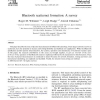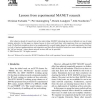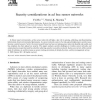ADHOC
2005
14 years 11 days ago
2005
This paper describes the issue of piconet interconnection for Bluetooth technology. These larger networks, known as scatternets, have the potential to increase networking flexibil...
ADHOC
2005
14 years 11 days ago
2005
After almost a decade of research into ad hoc networking, MANET technology has not yet affected our way of using wireless networks. In this paper we discuss lessons to draw and ba...
ADHOC
2005
14 years 11 days ago
2005
Mobility in ad hoc networks causes frequent link failures, which in turn causes packet losses. TCP attributes these packet losses to congestion. This incorrect inference results i...
ADHOC
2005
14 years 11 days ago
2005
ADHOC
2005
14 years 11 days ago
2005
In future smart environments, ad hoc sensor networks will play a key role in sensing, collecting, and disseminating information about environmental phenomena. As sensor networks c...
ADHOC
2005
14 years 11 days ago
2005
Power management is an important technique to prolong the lifetime of battery-powered wireless ad hoc networks. The fact that the energy consumed in the idle state dominates the t...
ADHOC
2005
14 years 11 days ago
2005
Recent advances in micro-electromechanical (MEMS) technology have led to the development of small, lowcost, and low-power sensors. Wireless sensor networks (WSNs) are large-scale ...
ADHOC
2005
14 years 11 days ago
2005
- The IEEE 802.11 standard is the most popular Medium Access Control (MAC) protocol for wireless local area networks. However, in an ad-hoc environment, the Point Coordination Func...
ADHOC
2005
14 years 11 days ago
2005
This paper describes an ad hoc networking scheme and routing protocol for emergency communications. The objective of the network is to collect damage assessment information quickl...
ADHOC
2005
14 years 11 days ago
2005
While sensor networks are going to be deployed in diverse application specific contexts, one unifying view is to treat them essentially as distributed databases. The simplest mech...






